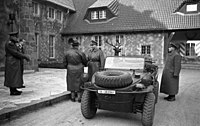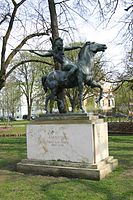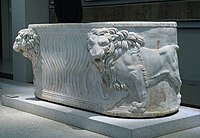Karinhall
History
This section needs additional citations for verification. (June 2023) |
Named in honour of his Swedish first wife, Carin Göring (1888–1931), the residence was constructed in stages from 1933 on a large scale.
In June 1933, Göring commissioned the architect Werner March to build a Swedish-style hunting lodge. Carin Göring's remains had first been interred in Sweden following her death, but were moved to Carinhall in 1934 and placed in a crypt on the grounds.
On 10 April 1935, Carinhall was the venue for Göring's wedding banquet with his second wife, Emmy Sonnemann.
Carinhall became the destination for many of Göring's looted art treasures from across occupied Europe.
Emmyhall
The Reichsjägerhof, Göring's smaller hunting lodge at Rominten in East Prussia (now Krasnolesye), in the Rominten Heath, was known as "Emmyhall" after his second wife.
Fate
To prevent Carinhall from falling into the hands of the advancing Red Army, the compound was blown up on 28 April 1945 at Göring's orders by a Luftwaffe demolition squad. Many of the art treasures were evacuated beforehand to Berchtesgaden, but many also remained behind, some hidden in bunkers or buried in the gardens, where they were discovered, looted, and vandalized by Soviet soldiers and local residents.
Only the monumental entrance gates, a few foundation structures, and decorative stones remain from the building. A bronze statue by Franz von Stuck, Kämpfende Amazone (1897), once at Carinhall, is now at Eberswalde. Another statue, Kronenhirsch by Johannes Darsow, can be found at Tierpark Berlin in the district of Friedrichsfelde. A Roman sarcophagus decorated with lions, which Göring had acquired in 1942 from an art dealer in Rome, was recovered from the ruins and is now on display in the Neues Museum in Berlin.
Gallery
-
Hitler and Göring head Carin Göring's funeral procession at Carinhall, 19 June 1934
-
Göring greeting an SS officer at Carinhall
-
Carinhall in ruins, 1947
-
Carinhall in ruins, 1947
-
Franz von Stuck: Kämpfende Amazone (1897) formerly at Carinhall, now at Eberswalde
-
Kronenhirsch (1937) formerly at Carinhall, now at Tierpark Berlin
-
Roman sarcophagus, formerly at Carinhall, now in the Neues Museum, Berlin
Legacy
In 1999, new interest was sparked by the book Görings Reich: Selbstinszenierungen in Carinhall which led to treasure hunters visiting the ruins, and concerns raised about the site becoming a neo-Nazi "shrine". The state government of Brandenburg ordered the remains of the tomb of Göring's wife to be demolished.
See also
References
- ^ Knopf, Volker; Martens, Stefan (2019). Gorings Reich: Selbstinszenierungen in Carinhall. Berlin: Christoph Links Verlag GmbH. pp. 25–31. ISBN 9783861533924.
- ^ As described by Kurt Reutti, who visited Carinhall in 1946 for the Zentralstelle zur Erfassung und Pflege von Kunstwerken, in order to salvage what remained of the collection; quoted by L. Puritani, "Biografien der Objekte: Görings römischer Löwensarkophag" (Museum and the City: Blog der Staatlichen Museen zu Berlin, 17 April 2020).
- ^ J. Kuhn, Kronenhirsch (Bildhauerei in Berlin).
- ^ L. Puritani, "Biografien der Objekte: Görings römischer Löwensarkophag" (Museum and the City: Blog der Staatlichen Museen zu Berlin, 17 April 2020).
- ^ Volker Knopf and Stefan Martens - Görings Reich: Selbstinszenierungen in Carinhall. Ch. Links Verlag, Berlin 1999.
- ^ "Berliners open treasure chest of evil" in The Times, 28 September 1999.
Sources
- Roger Manvell - Der Reichsmarschall. 1983. ISBN 3-8118-4370-2
- Leonard Mosley - The Reich Marshal: A Biography of Hermann Goering. 1975. ISBN 3-420-04727-4
- Carlos Díaz Domínguez - Tres colores en Carinhall 2011. ISBN 978-84-666-4192-0






